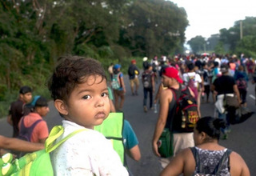The migrant caravan that traveled from Central America to the United States last month generated headlines — and angry rhetoric — long before it arrived. The situation reached fever pitch the Sunday after Thanksgiving when 500 or so migrants attempted to cross into the U.S. at the San Ysidro Port of Entry in Tijuana, Mexico. U.S. Customs and Border Protection agents responded by launching tear gas over the border.
Many of the migrants are seeking asylum, and almost all have been displaced from their communities —facts that two UC Santa Barbara social scientists argue have been omitted from the ongoing news coverage.
“The mainstream media has totally de-historicized and decontextualized the situation,” said Ralph Armbruster-Sandoval, a professor of Chicana and Chicano Studies. “They talk about gang violence, poverty and general misery, but without any background you’re left to wonder why that is. With no analysis or context, you’re thinking, ‘I’m a little bit sympathetic, but isn’t it their own government’s fault, and why don’t they just vote them out?’”
The problem is much more complicated, the scholars say, and decades in the making.
The U.S. Component
“The biggest question we need to ask is why this caravan is coming to the United States,” said William Robinson, a professor of sociology with affiliations in the campus’s global studies and Latin American studies departments. The answer, according to Robinson, lies in Central American history and U.S. policies that are responsible for “uprooting people and giving them no choice but to migrate here.”
This particular part of the story, he noted, begins in the 1970s and 1980s when Central America saw a number of radical and revolutionary upheavals aimed at overthrowing military dictatorships and oppressive family regimes that had been backed by the U.S. “That was successful in only one country — Nicaragua,” he said.
However, in the countries from which the majority of the current migrant caravans originate — Honduras, El Salvador and Guatemala — similar movements, those among peasants, workers, students, women and indigenous communities, were not able to achieve the same kind of social justice.
“The role of the U.S. in trying to transform those systems in favor of poor and outcast majorities was to intervene militarily, politically and economically to shore up the elite social orders and to prevent any deeper democratization of these societies,” Robinson said. “Things did settle down a bit and there were negotiated peace agreements, but nothing changed in terms of small elites controlling all the resources and a vast dispossessed majority.”
Read the complete article below.
Related Link:
News Date:
Thursday, December 13, 2018
December 18, 2018 - 8:43am







